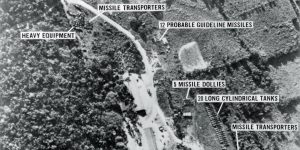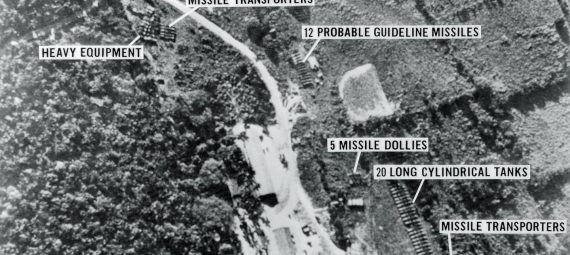The first three days of the Cuban Missile Crisis of October 1962 were the most nail-biting points of the Cold War. What started as a simple missile construction scare had led to many other complications, including the loss of an American spy plane shot down by the Soviets over Cuba. This whole crisis began when an American surveillance drone spotted bunkers in Cuba that were being used to create nuclear warheads for the Soviet Union in October of 1962. This obviously is a threat to the United States not only because the Soviets are gaining nuclear power but also because of the proximity of Cuba to the United States. Being only ninety miles from the state of Florida, John F. Kennedy and his administration worried of the Soviet’s intentions. Because of this, the United States military had every bomber on alert, every nuclear weapon ready to fire, and the bombers were refueled in air, meaning they were on alert 24/7. It is obvious that the United States were threatened by the Soviet occupation in Cuba and the nuclear construction happening there, and the people of the United States were being told that the American military had it under control. In a New York Times newspaper on October 27, the military had moved anti-aircraft missiles into Key West, Florida along with more active naval operations to protect the coast. This is important because throughout the whole newspaper, all that is addressed is what the United States are doing at home to defend the country and how much military they had moved into Florida, making the American people very nervous while at the same reassuring them that the military was doing everything they could to protect the United States.
Nikita Khrushchev, the first secretary of the communist party and man in charge in Cuba, wanted to negotiate with Kennedy and avoid war with the United States because he knew that it would lead to total destruction and create a nuclear wasteland across the world. Khrushchev’s first negotiation had the main goal of getting Kennedy to remove the Jupiter warheads in Turkey, and if the Americans did that, he would stop withdrawal the missiles from Cuba. The problem with this was not knowing how many war heads were in Cuba, and not knowing how many they could build the longer Kennedy took to take action in Cuba. “They are working night and day on missile sites. If the sites were completed, the Soviet Union would have the means to retaliate against U.S. territory if the administration ever decided to take military action against Cuba.” Not only was Kennedy being pressured by his administration, but he was also being pressured by his allies to make a strong decision and not back down. In a newspaper article that came out on October 26, Chancellor Adenauer of West Germany warns the West Germans that war tensions are higher than ever since the end of the second world war and urges Kennedy to stay strong and keep following the American way of handling Cuba, saying, “The United States owes it to it own freedom and the freedom of its allies to prevent the completion of these bases.”
Leffler, Melvyn P. For the Soul of Mankind : the United States, the Soviet Union, and the Cold War / Melvyn P. Leffler. 1st ed. New York: Hill and Wang, 2007. P.152-156
By SYDNEY GRUSON Special to The New,York Times. 1962. ADENAUER WARNS OVER CUBAN CRISIS: CALLS IT DANGEROUS AS EVER –SUPPORTS U.S. ANEW. New York Times (1923-Current File), Oct 27. http://newman.richmond.edu:2048/login?url=https://www.proquest.com/historical-newspapers/adenauer-warns-over-cuban-crisis/docview/115635898/se-2?accountid=14731.
“Army Pushes Florida Build-Up; Antiaircraft Missiles Moved in.” New York Times (1923-Current File), Oct 27, 1962. http://newman.richmond.edu:2048/login?url=https://www.proquest.com/historical-newspapers/army-pushes-florida-build-up-antiaircraft/docview/115640549/se-2?accountid=14731.


